Bronze replica in the style of the bronze casting of the Kingdom of Benin, southern Nigeria.
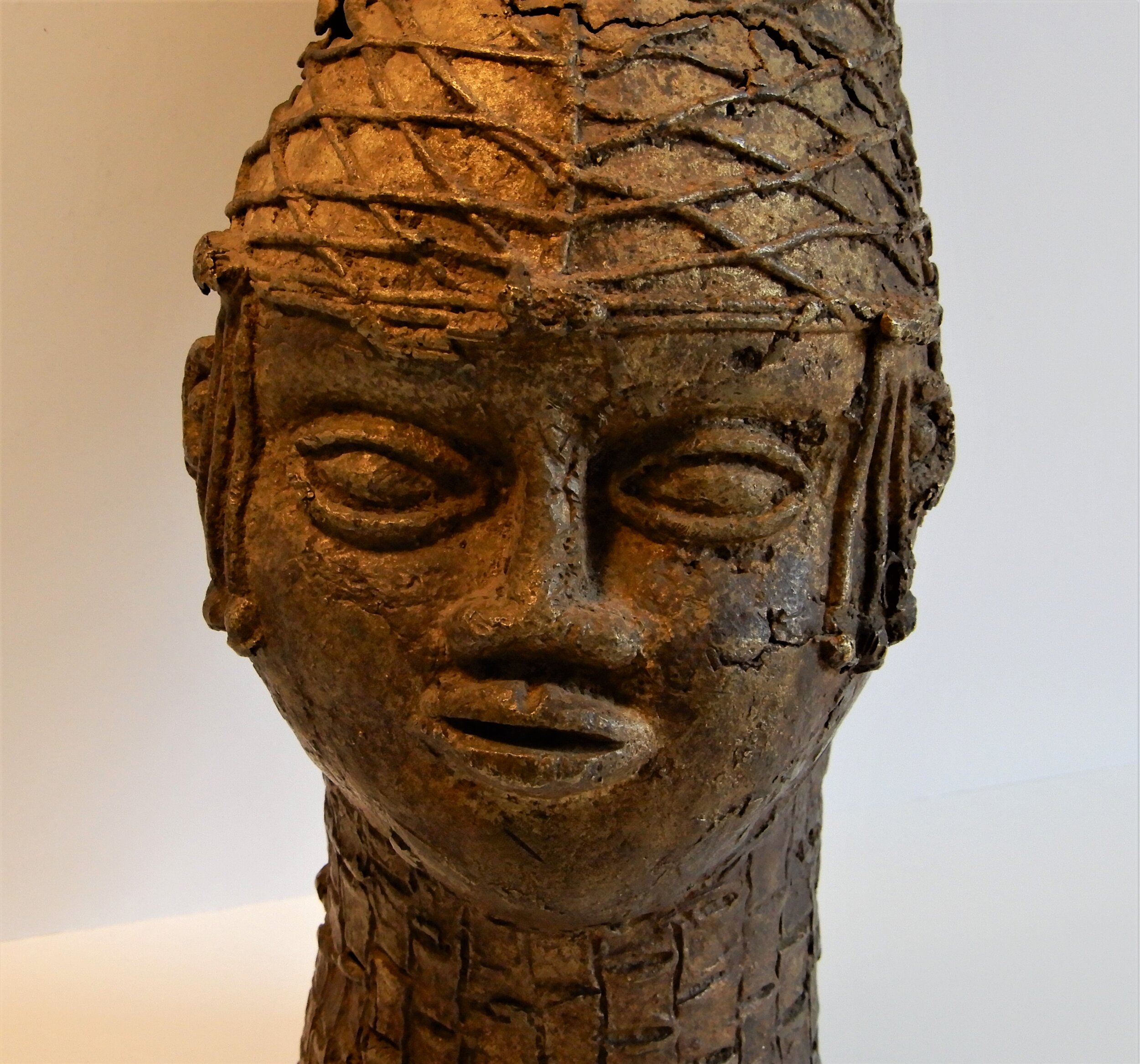
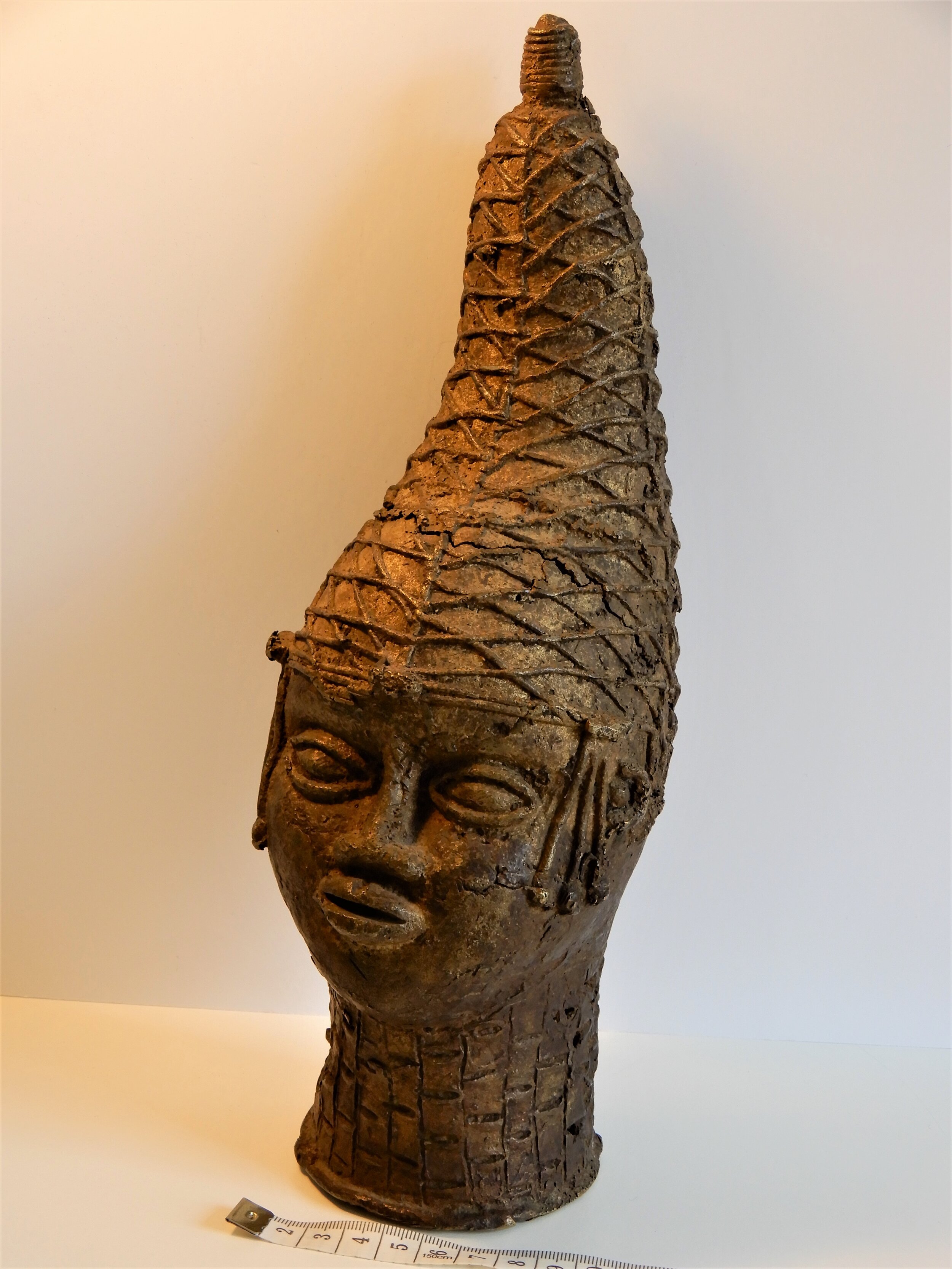
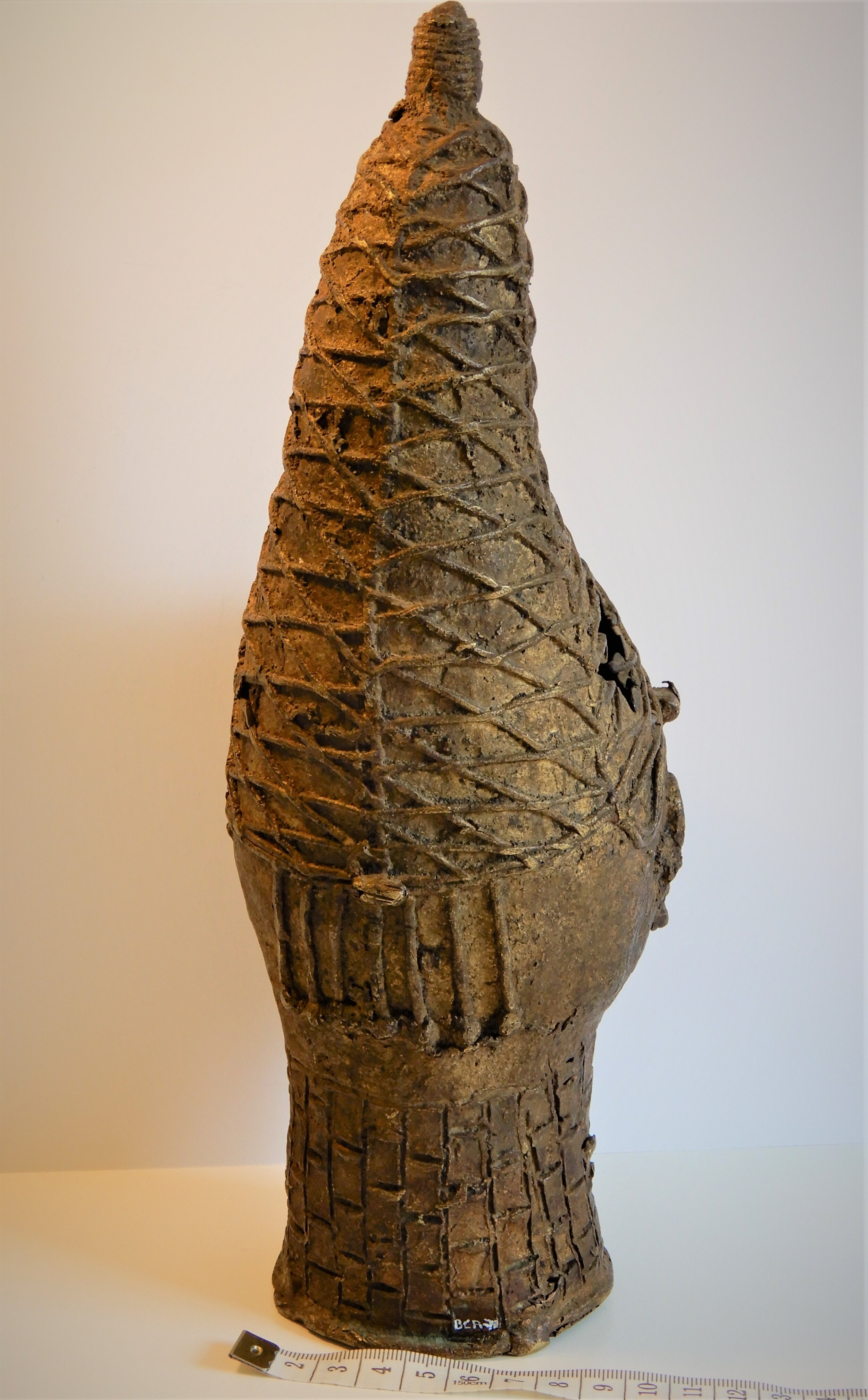
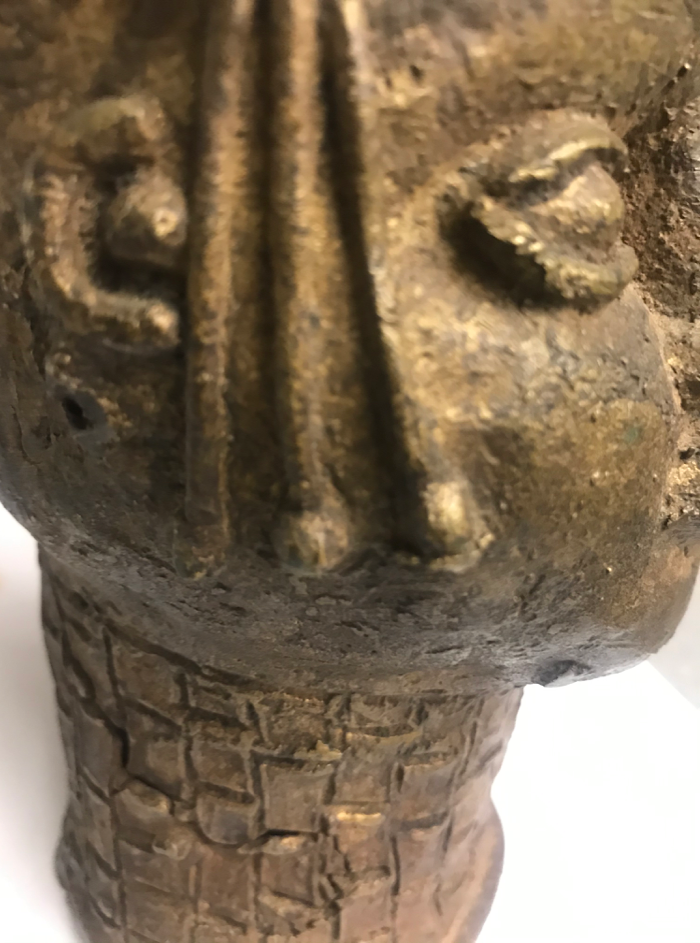
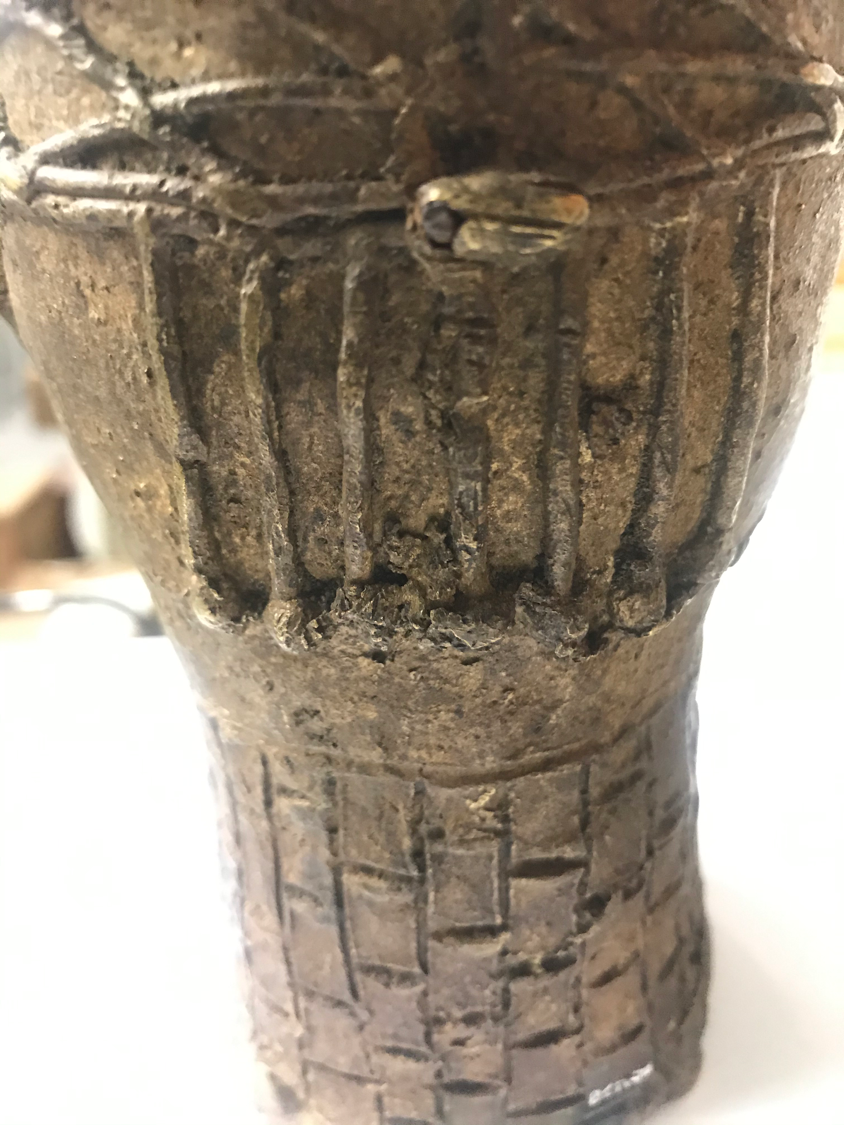
Listen
Decolonising The Archive (DTA) collaborated with Black Cultural Archives to research and curate some of the hidden mysteries behind their object collection:
A transcript is available below and can also be downloaded here:
“Being DTA, we took the initiative to incorporate a decolonial lens to the narrative so as to give a fuller picture to the histories and how they came to retell themselves in the archives of BCA. As such, join us as we travel all the way to Nigeria to speak to Mr Frank Adaniken, Chief Heritage Officer of the Benin Museum, who was able to pinpoint the facts around this replica.”
[Intro - Kayode, DTA]: Restoring Histories, a collaboration project between the Black Cultural Archives and Decolonising The Archive
[Subtitle]: Decolonising the Archive: re-contextualising and recreating a past, present and future that includes you
[Kayode]: The Black Cultural archives has teamed up with Decolonising The Archive as part of the Restoring Histories project, which focuses on the Queen mother headdress. Now this object was unlabelled, it originates from Benin, Nigeria, but there’s a lot of mystery surrounding this artefact because besides the name “Queen Mother headdress” there is actually very little known about this item in particular, we don’t know who donated it or how it ended up at the Black Cultural Archives. I spoke with Frank Adaniken, of Benin Museum, Nigeria, and he spoke a bit more about this queen mother headdress.
[Frank Adaniken]: I am Chief Heritage Officer, Benin Museum Branch, it’s a National Museum, Benin Museum Branch, that;’s where I am… That’s a typical Benin Future, yes, that is, the bronze, not too artistic like Benin bronze, not too artistic, the design is too poor, you understand?
[Kayode]: Yeah.
[Frank Adaniken]: In Benin, we have such futures, the future is the Queen Mother’s head, it’s called Idia head. I-D-I and A, Idia, that’s Queen idia, Idia is the name Ok, Idia is the name of the Queen?
[Frank Adaniken]: Yes, it's the name of the Queen.
[Kayode]: And do you know anything about Queen Idia?
[Frank Adaniken]: Yes, yes, Queen Idia is the wife to Oba Ozolua. Oba Ozolua is O-Z-O-L-U-A.
[Kayode]: And what period was this?
[Frank Adaniken]: The basic… let me give you from foundation, you understand, the Queen Idia is the wife to Oba Ozolua. Oba Ozolua reigned in 1481 AD. At this point, the (Esigie) was actually the heir to the throne, but when he ascended the throne, Oba Esigie, who is the son, had to fight to win and conquer his environment, Queen Idia, the mother of Oba Esigie was actually a warrior…A significant role in the rise and reign of her son Oba Esigie made him so popular that Oba Esigie had to confer on her Eguae Iyoba, which is a title meaning “The Palace of the Queen Mother”. Prior before then, the Queen mother, that is, the Oba’s mother (I think) ought not to actually live, you understand?
[Kayode]: So she was alive?
[Frank Adaniken]: Yes, she ought not to live, once an Oba is under the throne, the Queen Mother is by tradition not to live.
[Kayode]: Oh she has to die?
[Frank Adaniken]: Yes, she has to die for the son to reign.
[Kayode]: Okay
[Frank Adaniken]: But because of the role and the importance of Idia, the mother of Oba Esigie, Oba Esigie had no option than to allow the mother to live, and for the very first time in history, he titled a position the Egua Iyoaba, which means “The palace to the Queen mother”, and after then, after that period, that title became part and parcel of the palace. Yes.
[Kayode]: So why was…?
[Frank Adaniken]: In history, the Idia became a popular historical figure, due to when the ivory carving of the face was adopted as a symbol of FESTAC in 1977, and you are a Nigeria, you should know better of FESTAC 1977…
[Kayode]: It was a very important event
[Frank Adaniken]: You know, this figure, you know, FESTAC 1977 was a Black African festival, organised in some West African regions, and because they needed a figure to show, they chose the Queen’s Mother’s Head. And this Queen Mother’s head is among the looted artefacts from the palace of the Obanola [citation needed] in the period when the British invaded Benin in 1987
[Kayode]: Do you mean 1897?
[Frank Adaniken]: 1897 yes, 1897, so when this figure was chose, it became a pride to the Edo people and the Queen mother became a very popular figure, and along the line, great tourists from different nations come into the Igun market where bronze are cast to buy and decide to go and show the entire world of the Queen mothers head. Briefly, these bronze are specially made in a local fashion. The techniques, the technical mastery of the casting and the richness of the ivory were so impressive because it’s part of the palace, and the method used is traditional, it’s called cire perdue, which is the last wax. I don’t think the method is important here, because all you need is the history.
[Kayode]: The method is also important, everything, because we know nothing about it;
[Frank Adaniken]: OK, the method of making such bronze is called the Lost wax in English. A core of the general shape of the finished object like what you saw there is made in fine mould and a cover with a layer of wax which is molded to a final shape to your desired fineness is prepared, then this wax is successfully covered with a layer of mud, till it’s sufficiently thick enough to accommodate great heat, then, when you fire it, the wax inside, after dryness is melted, and is replaced, you know, there will now be a cavity inside wen the wax is melted away, and then, that cavity is replaced with a bronze, a molten bronze, that is, a liquid bronze, or alloy of copper as the case may be. When this liquid bronze is cooled, that is, it’s left to cool down, the covering of mud broken away, it reveals a fine structure, or bronze.
[Kayode]: Thank you very much for explaining!
[Frank Adaniken]: Yes, so that’s the detail concerning the method of preparation. Oba Esigie was the first to confer the title of the Queen Mother to his mother, Idia. And since then, all subsequent Oba have followed suit to see that that position is honoured… but till date, because that particular face representative of the mother, Idia, was used in the FESTAC 1977, this made the bronze, the head bronze a very popular one all over West Africa and all the entire world. And what you saw there, let me give you a physical description of what you saw there:
[Marker]: You are now listening to DTA Radio, where living archives meet airwaves.
[Frank Adaniken]: It represents the Queen Mother’s head wearing a hairstyle of a high pointed hairstyle vertically down the back and the side of the head. What I’m trying to explain is that… it’s a hairdo, it’s a hairstyle, in Nigeria and Benin hairstyle, pointed high vertically up and then covered with beads, and the beads are vertically running down the back and side of the head, it’s where two parallel iron stripes is sat on the forehead which are flanked by Benin ethnic marks, you’ll see it on the face, by each side of the eyeball. The neck is decorated with beads as you have seen there, and all these are typical representative of a Queen in Benin or Edo state. Thank you I think that’s all I will say concerning the physical description
[Marker]: You are now listening to DTA Radio, where living archives meet airwaves.
[Kayode]: And you’re saying this particular image is likely, did you say it was a replica or a fake?
[Frank Adaniken]: No, it’s not a fake, it’s a replica. The artistic designer didn’t put a finishing touch to it. Because in Benin, that hairdo seems to just move upward vertically with a little bend. Google it, you will see, just write the Queen mother’s head Idia, you’ll see the representative even the one in British Museum, because up till date, it’s still with them, it has not been returned to the country. It is the replica of it that we use in FESTAC 1977. The.. the British are saying that we are not capable enough to preserve it. SO that’s been the bone of contention
[Kayode]: How do you feel about that?
[Frank Adaniken]: Oh you know what it means, it’s our heritage, you know, it is our touchstone, it shows a representation of our past glory, you know it's something we cherish and want to take to our future generations born, so it’s sad but what can we say? But if you have the chemicals or whatever to keep it, the situation where part of us are seeing our heritage as some other thing as kind of against their religion, they are not looking at it - like the Christians they are agreeing that these are good, and you can keep your heritage and it’s not idol or whatever, but this other group they feel it’s idol and this thing ought to be destroyed and mot of our heritage are being destroyed in the North and that’s the truth. The world heritage and so called over several periods have been invaded and things destroyed there but what I want to say concerning that is that i don’t see the situation as trying to paint it let's say the way it is. but what we need actually need this thing is thing, if we can preserve it fine, if we can stand and uphold it, fine, but well only Gd can say what we are facing in this country, even at present, every person is hiding his head, human beings have no value talk less of the artefacts, blood are shed every day, physically, and then what will you soy, talk about the artefacts so those are the situations, God will help us to attend to all this situation. It is very needful for us to get that heritage back to Nigeria, it will be vey cherished and every one of us is looking forward because that have returned are quite preserved, that’s the truth as many that are in the country presently are quite preserved, they’re untouched they are being guarded and that’s the truth, thank you!
[Kayode]: Thank you once again for a very interesting story, this thing, all it had was “Queen Mother head”, but you provided some very vital information and I can’t thank you enough.
[Frank Adaniken]: Alright!
[Subtitle]: Decolonising the Archive: re-contextualising and recreating a past, present and future that includes you
[Intro - Kayode, DTA]: Restoring Histories: a collaboration project between the Black Cultural Archives and Decolonising The Archive
"I use the bronzes to talk about aspects of culture before European contact. Then we look at Benin state and ceremonial clothing, to show continuity.
Then I talk about how depictions of African people in European art changed to justify slavery, then we go into the Sons of Africa movement, which is the point of the workshop" - Ayshah, workshop leader
This is one of seven pieces in the collection, varying in size, design, age and possibly provenance. The commonality of these pieces comes from their composite material of brass, and the way in which they have been created to mimic various known Benin Bronzes.Who does it depict?
The woman most represented in the art of the royal court of Benin kingdom is the queen mother, Iyoba (lit. “mother of the Oba”) whose status derives from her roles as wife and mother.
In sculptures of cast bronze and carved ivory, the Iyoba is presented as a senior chief, a position oftem held by men.
The Iyoba embodies the possibilities for women to acquire wealth, prestige, influence and even immortality. Where women’s roles have very little permanent residence in court art, the representation of the Iyoba is unique.
The stylised intricate hairstyle, and elaborate head dress depicted in this sculpture, can still be seen in African hairstyles and dress worn today.
Do you know anything about this object?
Get in touch using this form.



A ‘Zulu love letter’ made from beads with accompanying information about the colour coding.